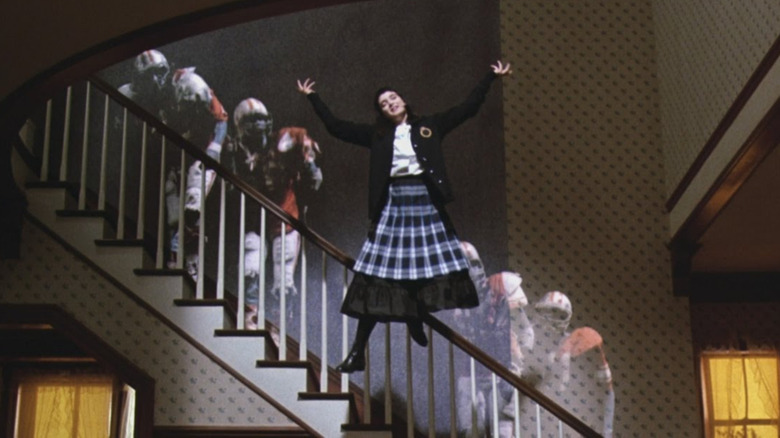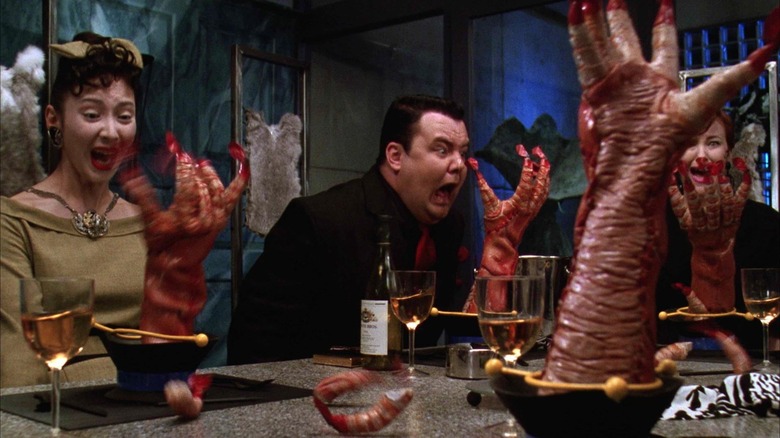Beetlejuice Brought In Harry Belafonte's Music For Its Energy - And Its Cheap Price
Today marks a sad day for the entertainment industry at large. Singer, actor, civil rights activist, and humanitarian Harry Belafonte has sadly passed away at the age of 96. Belafonte will be remembered for a great many things, but he is also one of the only artists to have a hit with the same song across two different decades. In 1956, the year of Elvis, Belafonte burst onto the charts with the timeless ear worm "Banana Boat (Day-O)" to quickly become the "King of Calypso" and create a new dance craze across the nation.
Fast forward to 1988, and the surprise success of Tim Burton's "Beetlejuice" introduced the "Day-O" song to a new generation of kids when the track was featured in one of the most memorable scenes in the film. The decision to use the song for the now infamous ghostly singalong dinner scene started with a phone call to Belafonte from none other than music legend David Geffen. The Geffen Film Company was backing Burton's bizarre vision for the film, and Geffen rang up the singer in 1986 or early 1987 to ask for permission to use his music. "I never had a request like that before," Belafonte told Pitchfork in 2018. "We talked briefly. I liked the idea of 'Beetlejuice.' I liked him. And I agreed to do it."
"Day-O" became the main tune audiences remember from "Beetlejuice," but one of his others songs is featured in the film as well, most notably during the closing number where Lydia (Winona Ryder) celebrates in mid-air lip syncing the 1961 hit "Jump in the Line (Shake Señora)." Belafonte's songs gave the movie a much needed jolt and they also happened to be incredibly affordable at the time, allowing the film to stay in budget without overpaying for other R&B songs that were too expensive to clear.
How the 'ghost with the most' chose calypso
During filming, the dinner scene where Delia (Catherine O'Hara), Charles (Jeffrey Jones) and their art snob guests are attacked by their shrimp cocktails needed something else to make it click in to place. According to Pitchfork, Jones recalled that it was actually O'Hara who suggested that a little calypso music would bring a some more life into the scene. Jones reportedly suggested records he remembered playing in his youth, such as "Yankee Dollar" or "Rum and Coca Cola" by Lord Invader, as well as Belafonte's "Day-O." The song turned out to be a perfect fit for the scene and Jones remembered that it happened to be incredibly affordable, too. He recalled, "I think it was like $300 to do it?"
Marjorie Lewis, an ambitious development executive at Geffen Film Company at the time, remembered how difficult it was to get a fair price when you're working for a Hollywood mogul. "Every time somebody heard the words 'David Geffen,' they raised the price," Lewis told The Ringer.
Luckily, more expensive R&B classics like "When a Man Loves a Woman" were scrapped in favor of Belafonte's discography, which quickly became one of the most defining parts of Burton's "Beetlejuice." It would take "Day-O" into heavy rotation on top-40 radio stations for the first time in over 30 years. For a generation of goth kids who had The Cure's 1987 album "Kiss Me, Kiss Me, Kiss Me" on repeat, the fact that Belafonte's "Day-O" song broke through and touched a nerve is something of a minor miracle. If "Beetlejuice 2" does ever see the light of day, hopefully his songs can find a new audience all over again.

